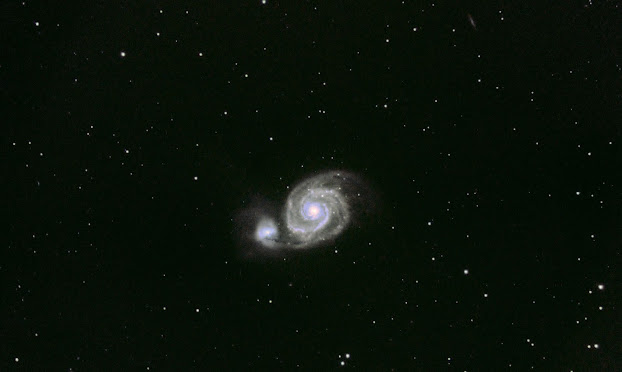The coronavirus pandemic put my astro-imaging on hold. Two favorite Harvard MA public area dark sites are temporarily closed due to the pandemic. Luckily I was recently able to image from the unlighted parking lot of a friendly fruit stand with a great view of the skies. Thanks to surrounding towns Harvard's skies are starting to rival the light polluted skies of Boston suburbs. That said they are still worth traveling to.
With two rare clear sky nights in a row I was able to do quite a bit of galaxy imaging using the Starizona Night Owl focal reducer alluded to in earlier posts. I decided to experiment with 15 x 1min sub-frames instead of the more typical 6 x 5min I've used in the past. The results are a pleasant surprise. UPDATE: Actually, according to Robin Glover's CMOS color camera astrophotography YouTube video it's not such a surprise after all.
Interesting note: Images from the first and better night sky-wise were plagued with an unpleasant gradient brightening on the left side. I hypothesized was due to flat frames with histograms with too many points below 20%. Flat frame histograms should fall between 20% and 80%. I adjusted this on the second night and in a Hail Mary play applied one of these flats to the previous night's images. Any serious imager knows this is a no-no because flats must be taken with the exact optical configuration used to acquire the images. Despite this, the result was a successful, albeit imperfect salvaging operation made possible because I typically insert the camera with the same orientation around to the telescope's optical axis.
Note: Galaxy Season refers to the many Coma cluster galaxies in the in the southern spring evening sky. Also, Galaxy season doesn't preclude imaging comets, globular clusters or gaseous nebulae as exemplified by the first four images.
 |
Comet C/2017T2 PANSTARRS
|
 |
.Messier 3 Globular Cluster
|
 |
Messier 13
|
 |
Messier 97 Owl Nebula
|
 |
Messier 51 Whirlpool Galaxy
|
 |
Messier 63 Sunflower Galaxy
|
 |
Messier 85
|
 |
Messier 94
|
 |
Messier 101
|
 |
Messier 106
|
 |
| Messier 109 |
 |
| NGC4613 Whale Galaxy |


















